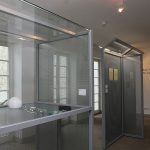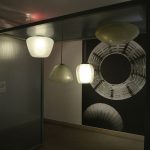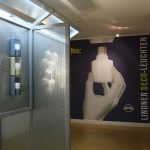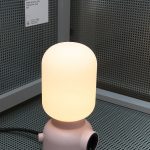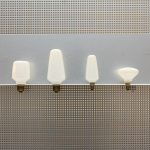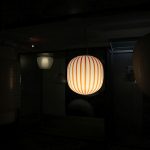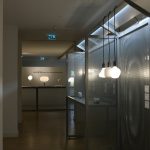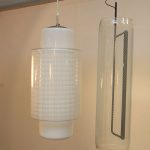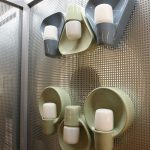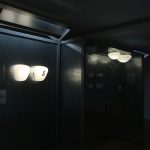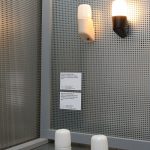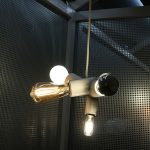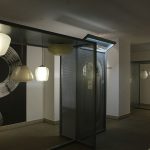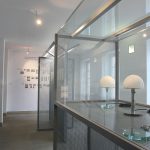Wilhelm Wagenfeld: Lamps @ the Wilhelm Wagenfeld Haus, Bremen
“I assure you that you and your work are the model case for what the Bauhaus has been after” wrote Walter Gropius to Wilhelm Wagenfeld in April 1965.
Just how Wilhelm Wagenfeld developed that “model case” “after” Bauhaus is explored, at least in terms of one design genre, in that genre for which Wilhelm Wagenfeld is most popularly known as a Bauhaus model, in the exhibition Wilhelm Wagenfeld: Lamps at the Wilhelm Wagenfeld Haus Bremen.
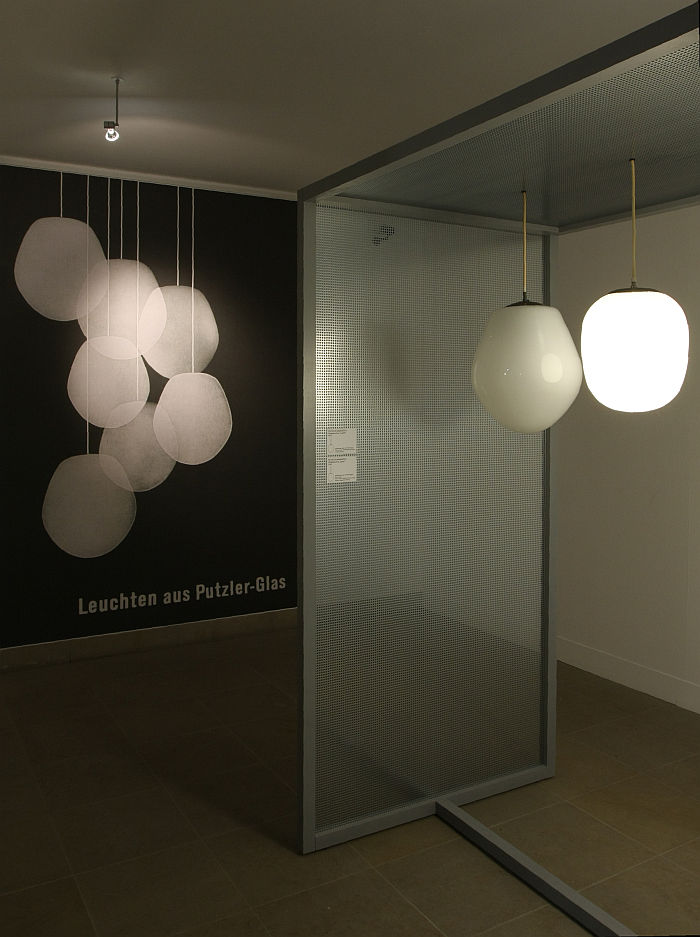
Tropfen (l) & Düren (r) by Wilhelm Wagenfeld for Glashütte Peill & Putzler, as seen at Wilhelm Wagenfeld: Lamps, Wilhelm Wagenfeld Haus, Bremen
This year of all years it would have been relatively simple for the Wilhelm Wagenfeld Stiftung to have presented a review, a celebration, of the Wagenfeld “Bauhaus Lamp”, for there can be, as the exhibition states, no object which stands as a more unambiguous symbol of Bauhaus than Wilhelm Wagenfeld’s 1924 glass and metal lamp, the “Bauhaus Lamp”, a phrase first coined in 1928 and thus underscoring the object’s inherent and contemporary relationship to the school: in 1928 it was understood as being reflective of Bauhaus, the name isn’t a later, lazy, attempt to forge a, contrived, relationship. Such a celebration would however have been too simple, arguably frightfully dull and certainly not in the interests of Wilhelm Wagenfeld, whose legacy, ideals and creativity the Stiftung exists to protect, advance and promote.
Much more pleasingly the Wilhelm Wagenfeld Stiftung took the decision to explore Wagenfeld’s lighting design work post-Bauhaus, their first ever in-depth exploration of the circa 150 lighting designs Wagenfeld realised, and for all to explore how the understanding of design that Wilhelm Wagenfeld developed in the course of his two years at Bauhaus Weimar expanded, evolved and developed in a post-Bauhaus, post-War society.
Wilhelm Wagenfeld: Lamps does however open with Bauhaus, and yes with that lamp, as an original original and as an original re-edition, and which in addition to symbolically marking the starting point of the investigation, the source as it were from which everything that is to come radiates, also stand as twin lighthouses, guiding you in and ensuring a safe further passage.
Primarily however the opening chapter concerns itself with Wagenfeld’s time at Bauhaus, including a copy of his application letter, dated 14.10.1923: and a copy of his acceptance, dated 15.10.1923. A speed of administrative process which one the one hand stands testament to the efficiency of the postal service in the 1920s, and which on the other hand could be related to the work samples he submitted with his application, or could be related to a note on the acceptance that Christian Dell, Wagenfeld’s former teacher at the Zeichenakademie Hanau, and the then Werkmeister in the Weimar Metal Workshop, considered Wagenfeld a “brauchbarer Handwerker”, a suitable craftsman. In how far Dell was also responsible for Wagenfeld’s decision to apply to Bauhaus is lost in the mists of time, he was, we learn from Wagenfeld’s letter, certainly aware of the application; that Christian Dell was correct in his assessment of Wagenfeld, and that Wagenfeld understood how to combine his craft skill with an artistic flair, material comprehension, economic awareness and a sensibility for the contemporary needs of contemporary society to create meaningful contemporary industrial products, is explained and explored in the course of Wilhelm Wagenfeld: Lamps.
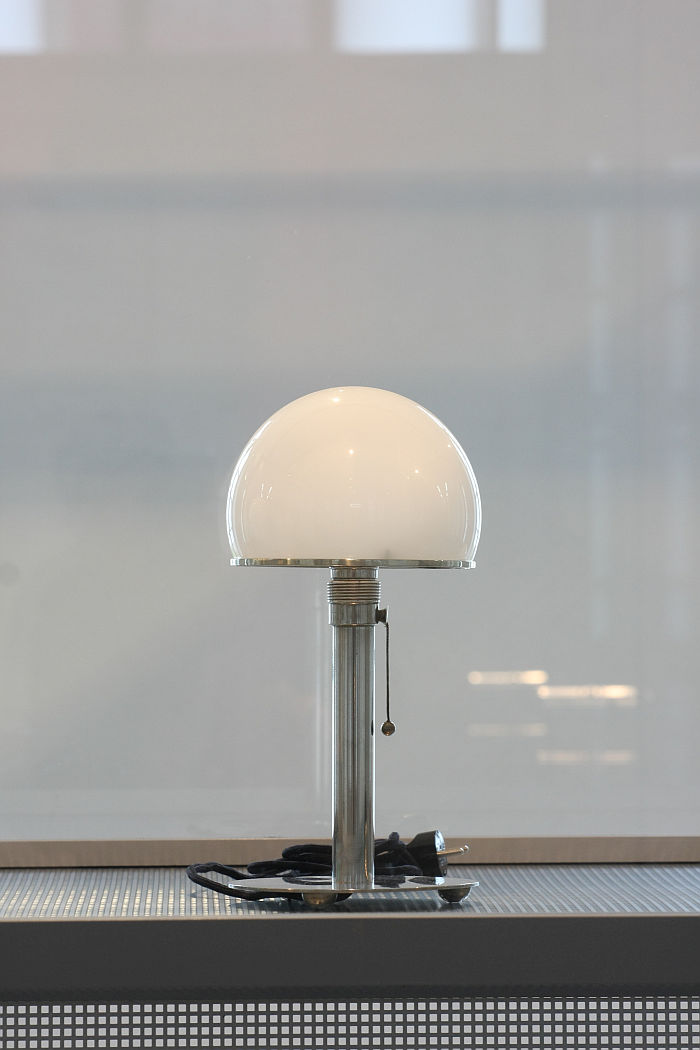
A lamp that needs no introduction….., an original, original from 1924 as seen at Wilhelm Wagenfeld: Lamps, Wilhelm Wagenfeld Haus, Bremen
When Bauhaus moved to Dessau Wilhelm Wagenfeld remained in Weimar, joining, along with the likes of Otto Lindig or Erich Dieckmann, the unofficial official successor institute, the Staatlichen Bauhochschule Weimar, and although in the immediate post-Bauhaus years he did produce lamps, most notably those sold through Weimar Bau und Wohnungskunst, and which, as previously noted, featured in the Frankfurter Register of recommended products for the inter-War Neues Frankfurt housing estates, no lamps from that period are on show in Bremen; because, and according to Wilhelm Wagenfeld Stiftung’s Director Dr. Julia Bulk, there aren’t any, or at least none the Wilhelm Wagenfeld Stiftung is aware of, so if you have one, do please get in touch with Bremen; consequently, the post-Bauhaus story picks up post-War in the 1950s with Wagenfeld’s cooperations with Düren based Glashütte Peill & Putzler, and lamps which demonstrate in their organic, naturalistic, drop-esque, forms a very clear move away from the rigid, dogmatic?, geometry of the Bauhaus years, and thus from that which in many regards is the defining feature of Wagenfeld’s Bauhaus Lamp, certainly the defining popular understanding of the Bauhaus Lamp. And from which Wagenfeld moved even further away when with (a) works such as the 1958 Berlin or the 1953 Pomona for Peill & Putzler he began to experiment with decoration, and (b) in his cooperation with, arguably, his most important partner, Bamberg based Lindner, he began to incorporate colour into his work.
Given the lion’s share of the exhibition space Wagenfeld’s cooperation with Lindner is notable not only for the sheer number of products it brought forth, but for all for the range of both product types and approaches to solving the technical and economic demands industrial lighting production sets a designer; and that, primarily, in context of what would be classed today as architectural lighting, of what a 1955 Lindner catalogue describes as lighting for kitchen, cellar, bathroom, toilet, staircase and outdoors; and for all of lighting whose necessity makes it essentially anonymous. But essential.
In our post from Light & Building Frankfurt 2018 we noted that because with such architectural lighting the focus is so firmly on the technical aspects, the formal aspects can all too often be ignored: the function indicating an appropriate form, and why move on from that? As Wilhelm Wagenfeld: Lamps satisfyingly explains Wagenfeld made use of technological advances but never lost sight of the importance of the formal character of his work, nor that his designs not only had to be produced as efficiently and economically as possible, but also had to be responsive to the rapidly evolving realities of post-War housing, post-War society and post-War consumers. Something exemplified by his use of the standardised elements, modular systems, multi-functional objects, et al industry needed, while also offering objects responsive to the consumers of the period be that through, for example, formal variation or offering products in a choice of colours, largely, pastel tones, and thus allowing for a degree of individuality in otherwise standardised systems.
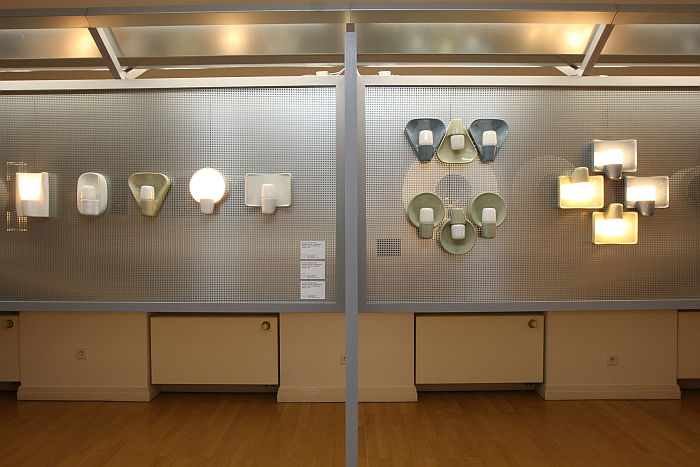
The modular Systral frames and Elroyal bulbs by Wilhelm Wagenfeld for Lindner, as seen at Wilhelm Wagenfeld: Lamps, Wilhelm Wagenfeld Haus, Bremen
Interwoven through the examples of Wilhelm Wagenfeld’s works are lighting designs by contemporary designers such as, and amongst many others, Patricia Urquiola, Form Us with Love, Front or Stefan Diez, and works which neatly illustrate not only that many of the contemporary issues being explored by designers are similar to those a Wagenfeld was exploring in decades past, that much as society has evolved, it also hasn’t, but that many of the ways Wilhelm Wagenfeld went formally and artistically remain thoroughly contemporary; be that the glass-in-glass works he developed for Peill & Putzler, the incorporation of plug sockets into the bathroom mirror lights for Brunnquell Ingolstadt, or the decorative lightbulb. The contemporary fascination with the light bulb as an autonomous light source may make such appear a recent development: with his, improbably monikered, Eldeco range for Lindner Wagenfeld was developing decorative, stand-alone, light bulb lamps in the late 1950s. And a range which reminds us of what Walter Schnepel, in many regards the re-discoverer of Wagenfeld’s Bauhaus Lamp, explained to us was his fascination with the lamp, namely the, “reduction of a lamp to its basic elements.” With the Eldeco series Wagenfeld reduced it even further.
The final section completes the circle and brings the exhibition back to the Wagenfeld Bauhaus Lamp with a selection of 6 post-Bauhaus-Lamps that can equally be considered as further developments and/or comments on Wagenfeld’s 1924 design, including works by the likes of Gio Ponti, Gae Aulenti or Franco Albini/Franca Helg, indeed all 6 lamps are, interestingly, by Italians. And not a little amusing when one considers where most of the Wagenfeld Bauhaus Lamp plagiarisms come from, or at least came from.
And 6 works which may never have existed.
For, as we learn from Wilhelm Wagenfeld’s 1923 application letter, his initial plan to was to move to Vienna and join the Wiener Werkstätten, a reminder that Bauhaus weren’t the only circus in town in the 1920s; had the political and economic realities in Vienna of that period not ruled that out, Wagenfeld may never have joined the Metal Workshop at Bauhaus Weimar, almost certainly would never have created a reduced geometric lamp, and therefore couldn’t have influenced future lighting designs. Far less allowed for such a succinct, engaging, definition of Bauhaus.
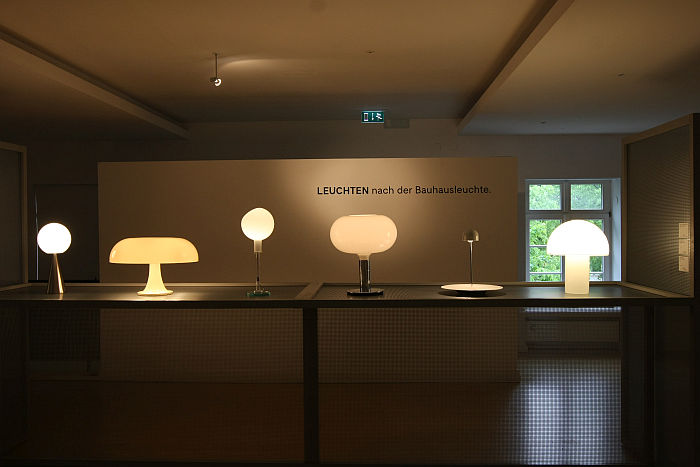
Works by Gio Ponti, Giancarlo Mattioli, Gae Aulenti, Franco Albini/Franca Helg, Vico Magistretti & Luciano Vistosi, as seen at Wilhelm Wagenfeld: Lamps, Wilhelm Wagenfeld Haus, Bremen
“Wagenfeld what are you doing?! You’re betraying Bauhaus!”, exclaimed László Moholy-Nagy in 1931 as he cast his gaze over some of the more organic forms Wagenfeld was developing for Schott & Gen. Jena, “We fought for spheres, cylinders, cubes and you’re making the Romantic. You’re making sentimental drops”1
Really? Is Wilhelm Wagenfeld’s work for Schott & Gen, works such as his 1930s tea service, and by extrapolation the organic, naturalistic, drop-esque lamps for Peill & Putzler, a betrayal of Bauhaus?
On the one hand Wagenfeld knew how to defend himself, was sure in himself of what he was doing in terms of the formal expression of his work for Schott & Gen., “No Moholy.”, he replied, “What we wanted was a romantic understanding of form which couldn’t be correctly translated into any material. So I had to go out from what I saw in the glass works. The original form of the glass is the drop and from this drop I’m going out now and try to find the new, organic form” And lest we forget, the glass domes of the 1924 lamp were produced by Schott & Gen. Not only was Wagenfeld developing as a designer, but he was assisting Schott & Gen develop as a manufacturer.
And on the other.
As we learn from Wilhelm Wagenfeld: Lamps, following the development of the lamp Walter Gropius decided to present it at the 1924 Grassimesse, Wagenfeld himself, like any good student, manning the stand, and armed with some 30 examples for sale. And subsequently noting that although the stand position was good and interest amongst visitors was high, sales were low…. something of which all design students should take note, success can take time, even fifty or sixty years after presenting your work at a fair, but it can come. The reason for the lack of sales being, according to Wagenfeld, the price: although conceived to be produced by industry, industry as such didn’t exist in 1924, industry was still largely craft, and thereby the 1924 lamp demanded a price that reflected its manual production process, rather than one its industrial philosophy and ideals indicated. Only later in Bauhaus Dessau, and through cooperations with, and staying in context of lighting, Leipzig based Kandem was it possible to produce in an industrial fashion with the associated price advantages. Wilhelm Wagenfeld wasn’t there and so it was left to the likes of Marianne Brandt, Hermann Gautel or Hin Bredendieck to realise the necessary designs.
Wilhelm Wagenfeld was however with the likes of Lindner and where he was able to achieve not only industrial production of lighting on a scale, one presumes, inconceivable at Bauhaus, but for all to realise everyday, accessible affordable objects, objects which responded to the practical, emotional, industrial, cultural and economic needs of the time. The utilitarian ethos of Volksbedarf statt Luxusbedarf, Everyday Needs not Luxury, may be associated with the Hannes Meyer Dessau era, but also, +/-, and generalising to point of falsehood, sums up a core part of the intention of Bauhaus, or at least after Gropius had overcome his craft fixation.
“Wagenfeld what are you doing?! You’re betraying Bauhaus!” ? Or just offending Moholy-Nagy’s obsession with the primacy of geometric forms?
Viewing Wilhelm Wagenfeld: Lamps one tends towards an answer, and a much better understanding of why Gropius could consider Wagenfeld a Bauhaus model case.
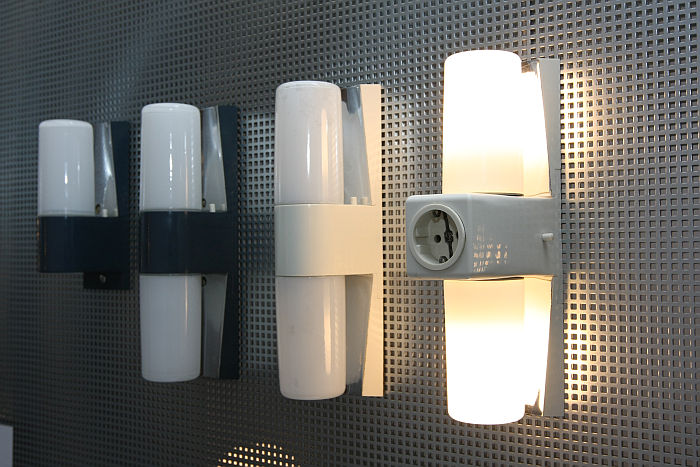
Mirror lamps, including with plug, by Wilhelm Wagenfeld for Brunnquell, as seen at Wilhelm Wagenfeld: Lamps, Wilhelm Wagenfeld Haus, Bremen
That Wilhelm Wagenfeld’s 1924 lamp was not only designed to be industrially produced, but that largely from standardised and/or off-the shelf, components being demonstrated in Wilhelm Wagenfeld: Lamps by an exploded glass version which allows a detailed study of the construction; and in many regards this standardised, off-the shelf construction approach is continued and repeated in the exhibition design from Jakob Gebert and Hanna Krüger with its use of industrial panels as industrial panels, and a design concept also representative of a photo showing Wagenfeld at work in Stuttgart in his “Werkstatt Wagenfeld” research laboratory, and in which lamps are seen hung from just such panels, and thus, when not recreating Wagenfeld’s creative environment, certainly allows for an understanding, and feeling, of it. Yes, the panels do give the marginal impression of being in a trade lighting shop, but also allow for an easy, accessible and uncluttered view of the essentials, without unnecessary distraction; much like Wagenfelds’ own design. The exhibition design and display concept being further enhanced and intensified by the fact that some lights are on and some off: on the one hand a technical necessity, not all the older lamps can or should be turned on, but also important to underscore the duality of a light’s function, that while a lamp must illuminate, and that in a useful, practical and functional manner, it also has to stand in a space when not illuminating it. And the one/off thereby allows for a very pleasing and regular switch of focus from practical to formal aspects, and thereby underscoring not only their relationship but how Wagenfeld understood and achieved the necessary balance between the two components of a lights character.
A relationship and balance which effectively begins with Wagenfeld’s 1924 lamp, a work which, and as the exhibition opines, is an industrial object which can stand in any domestic space; largely because while at no point attempting to deny it its industrial character, is clearly reflective of familiar, historic, pre-industrial, archetypes.
And which thereby places it in an interesting position in context of the “machine vs craft” debate that was running at the period, and for all the belief among the leading proponents of industrial production that new materials and production methods needed new forms. With his lamp Wagenfeld doesn’t directly contradict that, but does present a convincing argument that if formal changes are too sudden, one can alienate a large percentage of the public; that while evolution in formal character must always respond to prevailing realities, that should ideally be linked to the past, should allow the viewer, the user, to understand where it has come from, should, must, keep the user engaged.
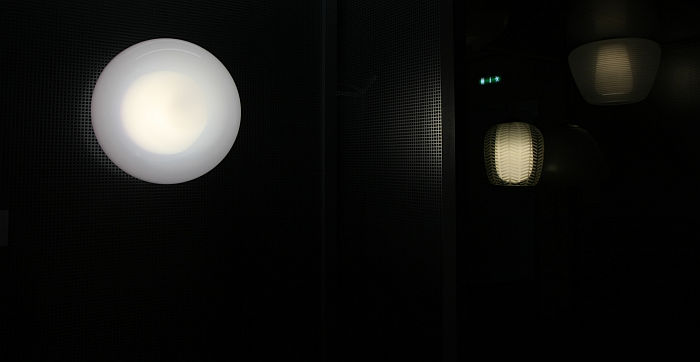
Mist by Front for Zero Lighting (l), and the Cora (m) and Helios (r) by Wilhelm Wagenfeld for Peill & Putzler, as seen at Wilhelm Wagenfeld: Lamps, Wilhelm Wagenfeld Haus, Bremen
A bijou exhibition, by necessity, the Wilhelm Wagenfeld Haus isn’t the biggest of spaces, inarguably a Wilhelm Wagenfeld deserves a much more spacious home, particularly in his native city, or better put, nation, if we follow the “Bremen” that stands after “Nationality” on his 1923 acceptance note, but we digress….. in addition to the direct focus on the lighting designs Wilhelm Wagenfeld: Lamps also takes the visitors on small, brief, diversions into subjects such as the move from craft to industry at Bauhaus Weimar, and the relevance therein for the Wagenfeld Lamp; and the medial reception of the lamp, then and now, underscoring that it has always been an image with a popular fascination that was regular disseminated and employed, was an Instagram star before Instagram, and in many regards is an image that is better understood and disseminated than a physical object. The one detour that isn’t made is that to Carl Jakob Jucker and his role in the development of the 1924 lamp; had the Wilhelm Wagenfeld Stiftung chosen to present a celebration of the lamp that omission would have been an issue, that however the focus is firmly on Wagenfeld’s post-Bauhaus, post-War works, it is less so, even if it is important to always remember the wider context in which the 1924 lamp arose.
A neatly paced exhibition which makes intelligent use of the Wilhelm Wagenfeld Haus’s floor plan to divide its narrative into logical, comprehensible and easily digestible chapters which explain the importance, the, maybe not the revolutionary, but certainly, well….. revolutionary, role played by Wilhelm Wagenfeld in the history and development of lighting design, something which the banal, almost prosaic character of the majority of the exhibited works belies, one must continually tell yourself that whereas today much of what is on show is self-evident, then it wasn’t, Wagenfeld was going new ways, trying new things, for the new age. In 1924 and subsequent decades. And for all is a presentation, which, this year of all years allows for some nice reflections on that most unambiguous symbol of Bauhaus, both as an object itself and its place in context to and off Bauhaus, but also of Wilhelm Wagenfeld and Bauhaus. And is an exhibition which in addition explains that the term “Wilhelm Wagenfeld Lamp”, though popular, in many regards misrepresents, underplays and overly simplifies Wagenfeld’s legacy, ideals and creativity. One must properly always speak of Wilhelm Wagenfeld Lamps.
Wilhelm Wagenfeld: Lamps runs at the Wilhelm Wagenfeld Haus, Am Wall 209, 28195 Bremen until Sunday October 27th
Full details, including information on the accompanying fringe programme, and as with the exhibition, Germany only, can be found at: www.wilhelm-wagenfeld-stiftung.de
1. At least according to Wagenfeld’s memory, we weren’t there and can’t confirm or deny what happened. Our source is a text in context of the Werkbundarchiv Berlin’ exhibition Unique Piece or Mass Product? quoting Wagenfeld from a 1960s radio interview. And while we don’t believe the quotes are 100% correct, don’t believe Wagenfeld’s memory was that good, do believe they reflect 100% the nature of the conversation and the positions of the protagonists
- Wilhelm Wagenfeld: Lamps, Wilhelm Wagenfeld Haus, Bremen
- Works by Wilhelm Wagenfeld for Peill & Putzler, as seen at Wilhelm Wagenfeld: Lamps, Wilhelm Wagenfeld Haus, Bremen
- Wilhelm Wagenfeld for Lindner, as seen at Wilhelm Wagenfeld: Lamps, Wilhelm Wagenfeld Haus, Bremen
- Plug by Form Us with Love for ateljé Lyktan, as seen at Wilhelm Wagenfeld: Lamps, Wilhelm Wagenfeld Haus, Bremen
- Elroyal, Elregent, Elcorona & Eldea bulbs from the Eldeco collection by Wilhelm Wagenfeld for Lindner, as seen at Wilhelm Wagenfeld: Lamps, Wilhelm Wagenfeld Haus, Bremen
- Filigrana by Sebastian Wrong for Established & Sons, as seen at Wilhelm Wagenfeld: Lamps, Wilhelm Wagenfeld Haus, Bremen
- Wilhelm Wagenfeld: Lamps, Wilhelm Wagenfeld Haus, Bremen
- Berlin by Wilhelm Wagenfeld for Peill & Putzler (l) & Guise by Stefan Diez for Vibia, the effect is only visible when illuminated, which at Guise will be/is now)
- Systral frames and Elroyal bulbs by Wilhelm Wagenfeld for Lindner, as seen at Wilhelm Wagenfeld: Lamps, Wilhelm Wagenfeld Haus, Bremen
- Wilhelm Wagenfeld: Lamps, Wilhelm Wagenfeld Haus, Bremen
- Eldeco by Wilhelm Wagenfeld for Lindner, as seen at Wilhelm Wagenfeld: Lamps, Wilhelm Wagenfeld Haus, Bremen
- Cluster Lamp by Joel Degermark for moooi, as seen at Wilhelm Wagenfeld: Lamps, Wilhelm Wagenfeld Haus, Bremen
- Fold Surface by Arik Levy for Vibia, as seen at Wilhelm Wagenfeld: Lamps, Wilhelm Wagenfeld Haus, Bremen
- Wilhelm Wagenfeld: Lamps, Wilhelm Wagenfeld Haus, Bremen
- Wilhelm Wagenfeld: Lamps, Wilhelm Wagenfeld Haus, Bremen
Tagged with: Bauhaus, Bauhaus lamp, Bremen, lighting, Lindner, Wagenfeld Lamp, Wilhelm Wagenfeld, Wilhelm Wagenfeld Haus
